Guitar Player: Vivian Campbell
- Web Site: www.viviancampbell.com
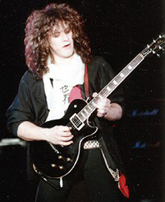
Songs you must hear: Stand Up And Shout and Don’t Talk To Strangers, and all lead work from the album Holy Diver. We Rock from the album The Last In Line. King of Rock and Roll from the album Sacred Heart.
Comments: Vivian Campbell joined Dio in 1982. Before that he had played from 1980 to October 1982 in a band called Sweet Savage. Vivian spent several years in Dio, until he left them in March 1986 after the Sacred Heart US tour. All the lead work on Dio’s Holy Diver is must hear. Combines speed with power and a nasty staccato technique.
What I learned from him: Well without a doubt his staccato phrasing techniques are the cornerstone of his playing. My solo song Marshall Law is a direct reflection of Vivian’s playing. Taught me how to build solos with a beginning, a middle and an end. He’s the guitarist I most model my playing after. His outro solo at the end of Stand Up and Shout is an example of his blazing fast staccato technique with perfect phrasing. Just flat out nasty…
Guitar Player: George Lynch
- Web Site: www.georgelynch.com
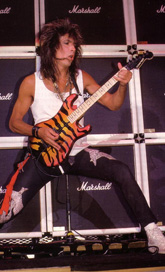
Songs you must hear: Mr. Scary and Kiss Of Death, and all lead work from the album Back For The Attack. Tooth and Nail from the album Tooth and Nail. Tierra Del Fuego and Big Head Of The Mama Love from the album Sacred Groove. River of Love from the album Wicked Sensation.
Comments: Guitarist George Lynch is one of a long line of guitarists to come from the California hard rock world. But one distinction that separates him from the rest of the pack is that he remains to be musically relevant in 2004 than the others. He has survived the shortcomings of the tangled music business. With a career that spans 30 years, George continues his legacy with new recordings that inspire fans around the world.
What I learned from him: Speed with class and technique. Can go from slow soulfull minor melodies to blistering fast 64th-note runs. Also wrote incredibly good backing tracks and catchy rhythms. Great song writer. His multi-tracking guitar techniques on Mr. Scary are ear candy for the senses leaving you asking …”How did he do that?” Lynch’s Back For The Attack has maybe the best distorted guitar tone ever recorded.
Guitar Player: Stevie Ray Vaughan
- Web Site: www.srvofficial.com
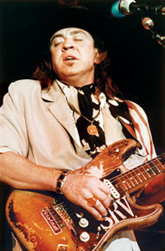
Songs you must hear: Love Struck Baby and Pride and Joy, and all lead work from the album Texas Flood. Voodoo Chile (Slight Return) from the album Couldn’t Stand the Weather. Anything by him really…
Comments: With his astonishingly accomplished guitar playing, Stevie Ray Vaughan ignited the blues revival of the ’80s. Vaughan drew equally from bluesmen like Albert King Otis Rush and Muddy Waters and rock & roll players like Jimi Hendrix and Lonnie Mack as well as the stray jazz guitarist like Kenny Burrell developing a uniquely eclectic and fiery style that sounded like no other guitarist, regardless of genre. Vaughan bridged the gap between blues and rock like no other artist had since the late ’60s. For the next seven years, Stevie Ray was the leading light in American blues consistently selling out concerts while his albums regularly went gold. His tragic death in 1990 only emphasized his influence in blues and American rock & roll.
What I learned from him: Attitude…Pure and simple. I have an old VHS tape of Austin City Limits from Stevie playing in 1983. His rendition of Voodoo Chile (Slight Return) sends chills down my spine every time I see it. His “I don’t care if it is too loud…” attitude made everyone in the first three rows move their chairs back…while being in total control of his instrument. Sheer genius…
Guitar Player: Jake E. Lee
- Web Site: www.charvel.com/features/jake-e-lee
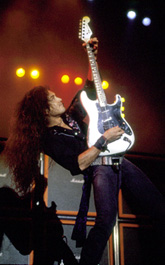
Songs you must hear: Bark at the Moon and Rock ‘n’ Roll Rebel, and all lead work from the album Bark at the Moon. Highwire and Rumblin’ Train from the album Bandlands. Lightning Strikes, Secret Loser and Shot in the Dark, from the album The Ultimate Sin.
Comments: Filling the shoes for a deceased guitar God is never an easy task. Yet, Jake brought his own musical style, showmanship and fire to Ozzy’s music. When Ozzy Osbourne needed a permanent replacement for the deceased Randy Rhoads, he came to Los Angeles to audition players and eventually hired Jake E. Lee. Lee played with Osbourne in late 1982 and early 1983 still supporting the Diary of a Madman tour. Osbourne and Jake kept touring though while working on Bark at the Moon, their next album. They released the hit single “So Tired”, which got airplay regularly on MTV and radio. Other singles included “Bark At The Moon” and “Rock ‘n’ Roll Rebel”.
What I learned from him: Learning to play guitar without using the tremolo bar is probably the single biggest thing I learned from Jake. I’ve been playing guitar for 25 years and still only use the whammy bar less than 3-5% in my playing. Massive finger vibrato technique, blistering technical speed, low-E dive bombs using just the neck or tuning machines, finger-tapping with the thumb to access more frets, pick glissing, pick fret tapping and pick scratching, use of feedback, massive amount of amp volume to get gain and tone and expert showmanship are all part of the Jake E. Lee arsenal.
Guitar Player: Michael Schenker
- Web Site: www.michaelschenkerhimself.com
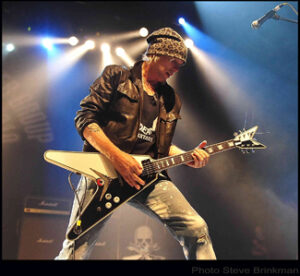
Songs you must hear: Lights Out and Love to Love, and all lead work from the album Lights Out. Coast To Coast from the album Lovedrive. Captain Nemo, Rock My Nights Away and Into The Arena, from the live album Rock Will Never Die.
Comments: Schenker has had a long career that has seen him rise to become one of the most influential and respected rock guitarists working today. He started playing in his early teens when his brother Rudolf brought home a Flying V guitar, which captured Michael’s imagination. Schenker debuted with Scorpions on their debut album Lonesome Crow at age 16 and was lauded at the time for his mature technique. He is know as master at live improvisation soloing.
What I learned from him: His use of the wah-wah pedal as an accent to his solo playing is completely masterful. The construction of his instrumental songs is something I model my own songs after. The beauty of Schenker is in his simplicity. Basically using just a wah-wah pedal, a Marshall JCM 800, 50-watt amp and his Gibson Flying V, he got so many sounds out of the guitar. Taught me to keep my guitar signal clean and focus more on the guitar playing as opposed to using a bunch of effects to cover up a lack of guitar proficiency. His use of the wah-wah pedal in his solo phrasing still influences guitarist today.
